Sitting
How to Sit
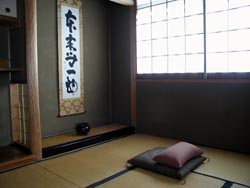
Regarding the actual practice of zazen, Zongze writes as follows in the
Zazengi:
When you wish to sit in meditation, first put down a thick cushion in a quiet place. Wear your robe and belt in a nonconstricting manner, and comport yourself properly. Then sit in the full lotus position.
For those living in the city, a truly quiet place to meditate is not always available. Generally one must settle for a place where outside sounds are at a minimum—in a study, for example, or a bedroom. Those who have a garden may wish to sit by its side, where they can be as close as possible to nature.
Although a bit of noise rarely prevents people from meditating successfully, the old texts warn against sitting where the wind is strong or the sun is hot.
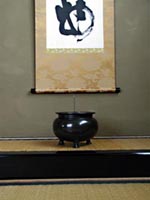
Placing religious objects in the meditation room helps to create an appropriate atmosphere. In Zen monasteries an image of Manjusri, the Bodhisattva of Wisdom, is always placed at the head of the Zen meditation hall, but in an ordinary household one may substitute an appropriate piece of calligraphy or a hanging scroll
depicting of a buddha or bodhisattva.
Good incense too is also conducive to meditation, with its delicate fragrance helping calm the mind and provide a sense of purification. A stick of incense ordinarily burns for thirty to forty minutes, a good length of time for a single sitting of zazen. Indeed, in the Zen monastery one sitting is called
isshu, “one incense stick.”
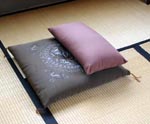 After an appropriate place for zazen has been selected, one is ready to begin preparations for sitting. These start, as the
Zazengi says, with setting down a thick cushion to sit upon. A thick cushion is much more comfortable for long sitting periods than a thin one, as it provides better support. It should be large enough that one’s knees do not protrude over the edges. If a thick cushion is not available, then two thin ones, one on top of the other, will suffice. On top of this thick square cushion set a smaller round cushion called a
zafu (if a zafu is not available, a regular cushion may be folded in half). This is to support the buttocks. Choose a
zafu of the right height; beginners usually find it easier to sit a bit higher.
After an appropriate place for zazen has been selected, one is ready to begin preparations for sitting. These start, as the
Zazengi says, with setting down a thick cushion to sit upon. A thick cushion is much more comfortable for long sitting periods than a thin one, as it provides better support. It should be large enough that one’s knees do not protrude over the edges. If a thick cushion is not available, then two thin ones, one on top of the other, will suffice. On top of this thick square cushion set a smaller round cushion called a
zafu (if a zafu is not available, a regular cushion may be folded in half). This is to support the buttocks. Choose a
zafu of the right height; beginners usually find it easier to sit a bit higher.
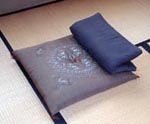 Loose-fitting clothes are best for zazen. If Western-style clothing is worn instead of robes, then the belt should be loosened a notch or two and the necktie removed. It is important not to be slovenly in appearance or behavior, however, which is why the
Zazengi stresses that you must “comport yourself properly.” A careless attitude leads to zazen
that is lacking in focus.
Loose-fitting clothes are best for zazen. If Western-style clothing is worn instead of robes, then the belt should be loosened a notch or two and the necktie removed. It is important not to be slovenly in appearance or behavior, however, which is why the
Zazengi stresses that you must “comport yourself properly.” A careless attitude leads to zazen
that is lacking in focus.
Regulating the Body
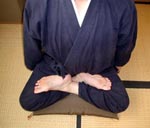
The
zazengi mentions two ways in which to arrange the legs when sitting in zazen: the full-lotus position
and the half-lotus position. In the former, place the right foot on the left thigh and the left foot on the right thigh (or vice versa), pulling the feet in as close to the trunk as possible so that the heels rest near stomach and the soles point upward. Center the back by rocking from right to left, gradually decreasing the arcs until one feels centered and balanced.
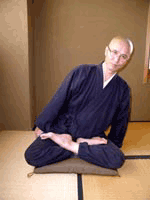 Next, lean forward from the hips with the back held straight. Raise the trunk once again to the upright posture, leaving the pelvis tipped forward and the lower back curved in. This posture, once one is accustomed to it, creates the most relaxed and stable foundation for zazen.
Next, lean forward from the hips with the back held straight. Raise the trunk once again to the upright posture, leaving the pelvis tipped forward and the lower back curved in. This posture, once one is accustomed to it, creates the most relaxed and stable foundation for zazen.
In the half-lotus position the right foot is under the left thigh and the left foot rests on top of the right thigh (or vice versa). Center the spine in the same way as with full lotus. In the half-lotus position the body’s center may be slightly out of balance, so it is good to switch legs from one sitting to the next.

 Those who can manage neither the full- or half-lotus positions may kneel in the Japanese
seiza style. Sitting on a zafu placed between the legs allows one to sit comfortably in
seiza for longer periods of time. For people with injuries or who for whatever reason cannot manage any of these positions, it is possible to meditate quite well in a chair. The back should be straight, as described above, and the pelvis should be a bit higher than the knees. Placing a cushion on the seat of the chair can raise the pelvis and make sitting more comfortable.
Those who can manage neither the full- or half-lotus positions may kneel in the Japanese
seiza style. Sitting on a zafu placed between the legs allows one to sit comfortably in
seiza for longer periods of time. For people with injuries or who for whatever reason cannot manage any of these positions, it is possible to meditate quite well in a chair. The back should be straight, as described above, and the pelvis should be a bit higher than the knees. Placing a cushion on the seat of the chair can raise the pelvis and make sitting more comfortable.
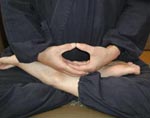 The right hand should be placed palm up on the lap; the left hand should be placed palm up on the right hand. The two hands should rest against the lower abdomen. The tips of the thumbs should touch with a light pressure, forming an egg-shaped oval. This hand position is known as the cosmic mudra.
The right hand should be placed palm up on the lap; the left hand should be placed palm up on the right hand. The two hands should rest against the lower abdomen. The tips of the thumbs should touch with a light pressure, forming an egg-shaped oval. This hand position is known as the cosmic mudra.
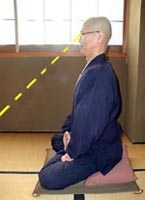 Keep the eyes open. Look straight forward at first, then drop the gaze 45 degrees till one is looking at a point on the floor about two meters in front of one. The eyes should have the half-open appearance of the eyes on a buddha statue. Sitting with eyes completely closed should be avoided, as it can easily lead to drowsiness or a lack of focus.
Keep the eyes open. Look straight forward at first, then drop the gaze 45 degrees till one is looking at a point on the floor about two meters in front of one. The eyes should have the half-open appearance of the eyes on a buddha statue. Sitting with eyes completely closed should be avoided, as it can easily lead to drowsiness or a lack of focus.
The upper body should be relaxed and free of tension, while the lower part should be settled and open. The head should be upright, with the face vertical and not inclined forward, and with the chin pulled in a bit. The top of the head should point to the ceiling, with the ears in line with the shoulders and the tip of the nose directly over the navel. The body’s center of gravity should settle naturally into the
tanden, a point about two inches below the navel.
Regulating the Breath
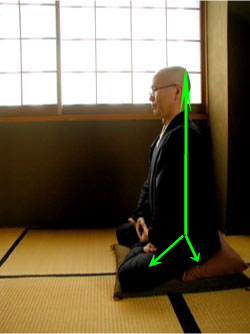
Once the body’s posture is balanced and settled, attention should be turned to the breathing. In many ways the breathing, which links and integrates body and mind, is the most important aspect of zazen. In zazen, one becomes fully aware of and open to each in-breath and out-breath. The exhalation should be long, deep, and relaxed, with the breath allowed to go out as far as it naturally wishes to go. At that point the inhalation will occur naturally. The breathing, both in and out, should be free of all tension and should flow from the
tanden. It can help to breathe with the sense that one is simply connecting the air inside of the body and outside of the body.
The practice of susokkan (breath-counting) is recommended for people meditating on their own. In
susokkan a person counts the exhalations from one to ten, then goes back to one and begins again. If
the count is lost, return to one. Be fully conscious of each and every breath, and be sure to maintain awareness as exhalation changes to inhalation and inhalation changes to exhalation.
Regulating the Mind
Regarding regulation of the mind, the
Zazengi advises as follows:
Keep your lower abdomen relaxed. Do not think of “good” or “evil.” When a thought arises be aware of it; as soon as you are aware of it, it will disappear. If for long periods you forget all ties, you will naturally become One. These are the essential techniques of zazen.
Sit with a feeling of complete openness, with the body and mind settled in the
tanden and free of all tension. When stray thoughts, fantasies, and judgments of right and wrong arise, illuminate them with an awareness that is relaxed but fully awake. Continue in this from one moment to the next, from one sitting period to the next, until one’s mind is clear and open. Look into the source of the mind as it is prior to thought.
Conclusion
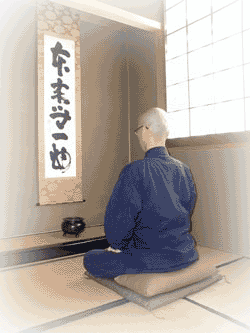
Although zazen can explained by dividing it into the elements of body, breath, and mind, it should be remembered that these three can not really be divided. Body and mind, linked by breath, work together as one. Whether you consider the body, the breath, or the mind, the other two elements are always present. A posture that is straight, balanced, and relaxed will help bring about a mind that open and fully aware; a mind that is open and fully aware will help bring about a posture that is balanced and straight.
The foundation of zazen is this harmonious whole of body, breath, and mind. Sit with a feeling of firmess and stability, like Mount Fuji rising from the plain into the sky. Even a short sitting in your home every day will help you attain this sense of calm openness. Joining a group of like-minded individuals to practice meditation is even more beneficial.

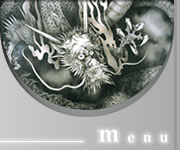
 Regarding the actual practice of zazen, Zongze writes as follows in the
Zazengi:
Regarding the actual practice of zazen, Zongze writes as follows in the
Zazengi:

 The zazengi mentions two ways in which to arrange the legs when sitting in zazen: the full-lotus position
and the half-lotus position. In the former, place the right foot on the left thigh and the left foot on the right thigh (or vice versa), pulling the feet in as close to the trunk as possible so that the heels rest near stomach and the soles point upward. Center the back by rocking from right to left, gradually decreasing the arcs until one feels centered and balanced.
The zazengi mentions two ways in which to arrange the legs when sitting in zazen: the full-lotus position
and the half-lotus position. In the former, place the right foot on the left thigh and the left foot on the right thigh (or vice versa), pulling the feet in as close to the trunk as possible so that the heels rest near stomach and the soles point upward. Center the back by rocking from right to left, gradually decreasing the arcs until one feels centered and balanced. Once the body’s posture is balanced and settled, attention should be turned to the breathing. In many ways the breathing, which links and integrates body and mind, is the most important aspect of zazen. In zazen, one becomes fully aware of and open to each in-breath and out-breath. The exhalation should be long, deep, and relaxed, with the breath allowed to go out as far as it naturally wishes to go. At that point the inhalation will occur naturally. The breathing, both in and out, should be free of all tension and should flow from the
tanden. It can help to breathe with the sense that one is simply connecting the air inside of the body and outside of the body.
Once the body’s posture is balanced and settled, attention should be turned to the breathing. In many ways the breathing, which links and integrates body and mind, is the most important aspect of zazen. In zazen, one becomes fully aware of and open to each in-breath and out-breath. The exhalation should be long, deep, and relaxed, with the breath allowed to go out as far as it naturally wishes to go. At that point the inhalation will occur naturally. The breathing, both in and out, should be free of all tension and should flow from the
tanden. It can help to breathe with the sense that one is simply connecting the air inside of the body and outside of the body. Although zazen can explained by dividing it into the elements of body, breath, and mind, it should be remembered that these three can not really be divided. Body and mind, linked by breath, work together as one. Whether you consider the body, the breath, or the mind, the other two elements are always present. A posture that is straight, balanced, and relaxed will help bring about a mind that open and fully aware; a mind that is open and fully aware will help bring about a posture that is balanced and straight.
Although zazen can explained by dividing it into the elements of body, breath, and mind, it should be remembered that these three can not really be divided. Body and mind, linked by breath, work together as one. Whether you consider the body, the breath, or the mind, the other two elements are always present. A posture that is straight, balanced, and relaxed will help bring about a mind that open and fully aware; a mind that is open and fully aware will help bring about a posture that is balanced and straight.
 After an appropriate place for zazen has been selected, one is ready to begin preparations for sitting. These start, as the
Zazengi says, with setting down a thick cushion to sit upon. A thick cushion is much more comfortable for long sitting periods than a thin one, as it provides better support. It should be large enough that one’s knees do not protrude over the edges. If a thick cushion is not available, then two thin ones, one on top of the other, will suffice. On top of this thick square cushion set a smaller round cushion called a
zafu (if a zafu is not available, a regular cushion may be folded in half). This is to support the buttocks. Choose a
zafu of the right height; beginners usually find it easier to sit a bit higher.
After an appropriate place for zazen has been selected, one is ready to begin preparations for sitting. These start, as the
Zazengi says, with setting down a thick cushion to sit upon. A thick cushion is much more comfortable for long sitting periods than a thin one, as it provides better support. It should be large enough that one’s knees do not protrude over the edges. If a thick cushion is not available, then two thin ones, one on top of the other, will suffice. On top of this thick square cushion set a smaller round cushion called a
zafu (if a zafu is not available, a regular cushion may be folded in half). This is to support the buttocks. Choose a
zafu of the right height; beginners usually find it easier to sit a bit higher. Loose-fitting clothes are best for zazen. If Western-style clothing is worn instead of robes, then the belt should be loosened a notch or two and the necktie removed. It is important not to be slovenly in appearance or behavior, however, which is why the
Zazengi stresses that you must “comport yourself properly.” A careless attitude leads to zazen
that is lacking in focus.
Loose-fitting clothes are best for zazen. If Western-style clothing is worn instead of robes, then the belt should be loosened a notch or two and the necktie removed. It is important not to be slovenly in appearance or behavior, however, which is why the
Zazengi stresses that you must “comport yourself properly.” A careless attitude leads to zazen
that is lacking in focus. Next, lean forward from the hips with the back held straight. Raise the trunk once again to the upright posture, leaving the pelvis tipped forward and the lower back curved in. This posture, once one is accustomed to it, creates the most relaxed and stable foundation for zazen.
Next, lean forward from the hips with the back held straight. Raise the trunk once again to the upright posture, leaving the pelvis tipped forward and the lower back curved in. This posture, once one is accustomed to it, creates the most relaxed and stable foundation for zazen.
 Those who can manage neither the full- or half-lotus positions may kneel in the Japanese
seiza style. Sitting on a zafu placed between the legs allows one to sit comfortably in
seiza for longer periods of time. For people with injuries or who for whatever reason cannot manage any of these positions, it is possible to meditate quite well in a chair. The back should be straight, as described above, and the pelvis should be a bit higher than the knees. Placing a cushion on the seat of the chair can raise the pelvis and make sitting more comfortable.
Those who can manage neither the full- or half-lotus positions may kneel in the Japanese
seiza style. Sitting on a zafu placed between the legs allows one to sit comfortably in
seiza for longer periods of time. For people with injuries or who for whatever reason cannot manage any of these positions, it is possible to meditate quite well in a chair. The back should be straight, as described above, and the pelvis should be a bit higher than the knees. Placing a cushion on the seat of the chair can raise the pelvis and make sitting more comfortable. The right hand should be placed palm up on the lap; the left hand should be placed palm up on the right hand. The two hands should rest against the lower abdomen. The tips of the thumbs should touch with a light pressure, forming an egg-shaped oval. This hand position is known as the cosmic mudra.
The right hand should be placed palm up on the lap; the left hand should be placed palm up on the right hand. The two hands should rest against the lower abdomen. The tips of the thumbs should touch with a light pressure, forming an egg-shaped oval. This hand position is known as the cosmic mudra. Keep the eyes open. Look straight forward at first, then drop the gaze 45 degrees till one is looking at a point on the floor about two meters in front of one. The eyes should have the half-open appearance of the eyes on a buddha statue. Sitting with eyes completely closed should be avoided, as it can easily lead to drowsiness or a lack of focus.
Keep the eyes open. Look straight forward at first, then drop the gaze 45 degrees till one is looking at a point on the floor about two meters in front of one. The eyes should have the half-open appearance of the eyes on a buddha statue. Sitting with eyes completely closed should be avoided, as it can easily lead to drowsiness or a lack of focus.